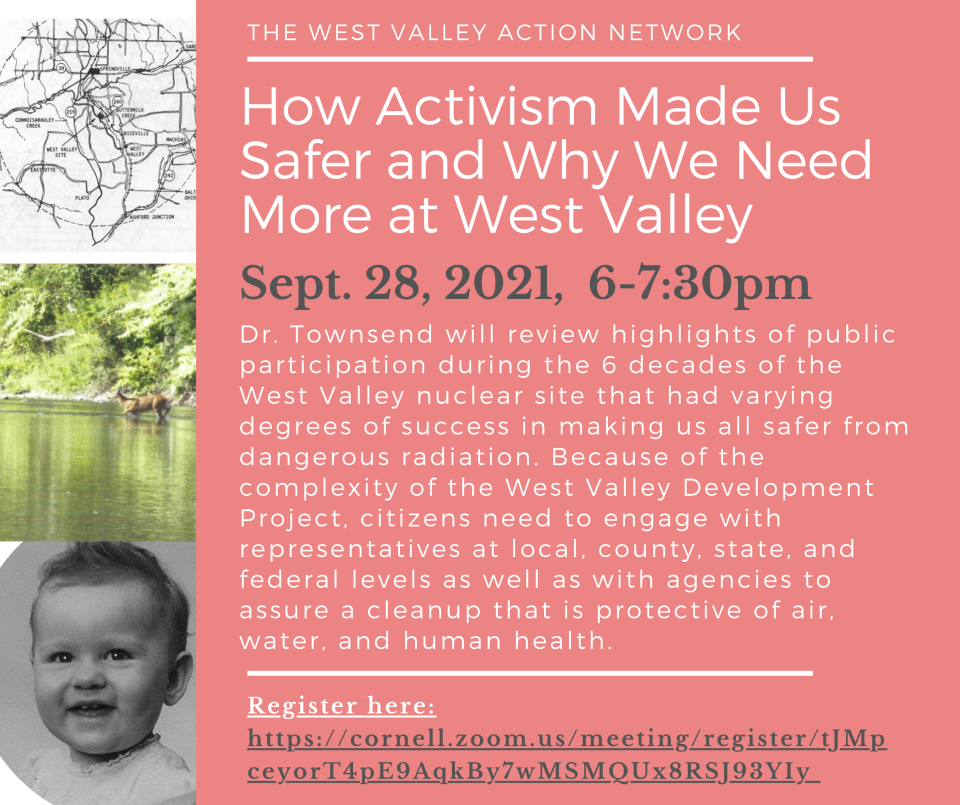Events Take Action
How Activism Made Us Safer and Why We Need More at the West Valley Nuclear Site
| Presenter(s): | Patricia K. Townsend, Ph. D. |
| Date: | September 28, 2021, 6-7:30 pm |
| Share: |

This is the sixth workshop in a series hosted by the The West Valley Action Network.
Register for the 9/28 session here: https://bit.ly/3khZ7C7
This workshop features Patricia K. Townsend, Ph. D. From her perspective as a social scientist, Dr. Townsend will review highlights of public participation during the six decades of the West Valley nuclear site that had varying degrees of success in making us all safer from dangerous radiation.
Individuals from many walks of life brought their different skills to bear on the challenging decisions of how to proceed in the work of remediating the highly polluted site. Some of those you have heard during this series of programs have been engaged for more than 40 years, others have a newly acquired passion for activism to help protect the Great Lakes region for our descendants.
Because of the political and bureaucratic complexity of the West Valley Development Project, citizens need to be engaged with their representatives at local, county, state, and federal levels as well as with agencies to assure a cleanup that is protective of air, water, and human health.
To help stop invisible but long lasting, dangerous radioactivity from getting into our air, water, soil, food and environment join us for a monthly series to learn about the West Valley NY Nuclear Waste Site. One of the most radioactive buildings at that site, and at all the nuclear power and weapons sites, in the country is slated to be demolished starting in 2021. The West Valley Action Network groups are calling for an enclosure during demolition and offsite real-time, publicly-reported radiation monitoring to see if radioactivity is getting out.
New Yorkers own the West Valley Nuclear Waste Site which is upstream and upwind of Buffalo and the rest of NY, the Seneca Nation of Indians Territories and Canada. Highly radioactive nuclear power and weapons waste was reprocessed there to extract plutonium and uranium, leaving one of the most intensely radioactive sites in the world. The US Department of Energy is tasked with “cleaning up” part of the site and they are about to demolish the above ground part of the super-radioactive reprocessing building as soon as Fall 2021. Much appreciation for the workers who have been suiting up and clearing out the building some of which was too radioactive for people and was only accessed by remote control. Workers are removing as much radioactivity as they can before the building(s) are demolished–but radioactivity remains in the thick walls and steel-reinforced structures. How much long-lasting radioactive material will be spread during demolition to communities, farm and dairy land up the food chain to our milk, cheese, eggs, food crops, meat and fish? To our waterways, air and soil?
Is the legal level of radioactive contamination a "safe" level, especially for females, young people, older people and those with existing health conditions and exposure to other cancer-causing environmental and household pollutants?
What other radioactive waste is at the site?
The sessions will answer these questions and raise more, providing avenues for meaningful public participation.
The current concerns are summarized at https://www.westvalleyaction.org/
1) We need an enclosure over the building(s) during demolition (and future excavation of below-ground waste and structures) at West Valley to prevent radioactive materials from spreading to the air, land, water, people, flora, fauna and environment AND
2) We need continuous, real time, offsite, air and water monitoring and publicly accessible reporting before, during and after the demolition of one of the most radioactive buildings in the nuclear power and weapons complex.
3) We must watchdog this demolition and the many cleanup steps that must follow--to prevent huge amounts of buried nuclear materials from leaking out and to isolate the waste that is now stored above and below ground at the site.
View other workshops from this series:
- (6/1) The History of the West Valley Nuclear Waste Site PART 1 and Action Needed in 2021
(6/22) Digging Deeper, The History of the West Valley Nuclear Waste Site PART 2 and Action Needed in 2021
(7/27) Protections Needed for WNY during the Demolition of the Most Radioactive Building , West Valley Action Network - (8/24) Indigenous Peoples for a Nuclear Free Future
Register for the (10/26) session here: https://bit.ly/3B1C855
The West Valley Action Network formed as a loose association of individuals and groups in 2009 to work for the full clean up of the West Valley Nuclear Waste site in West Valley NY, Cattaraugus County, draining north into Erie County and the Great Lakes. It is comprised of individuals and organizations in NY, the US and Canada working for the full cleanup of the West Valley nuclear waste site and includes the Coalition on West Valley Nuclear Wastes, Sierra Club, Western NY Environmental Alliance, Nuclear Information and Resource Service, Indigenous Women's Initiatives, Citizens' Environmental Coalition, the Western NY Peace Center, WNYCOSH, Citizens Campaign for the Environment, NYPIRG, the Adirondack Mountain Club, religious groups, sporting groups and many more.
Patricia K. Townsend, Ph. D., is an environmental and medical anthropologist who authored or co-authored multiple editions of college textbooks in both fields. Her early fieldwork as a cultural anthropologist was in the tropical forests of Papua New Guinea, with her husband Bill Townsend, a civil engineer. A subsequent research project took her to Superfund sites in Montana, Tennessee, and Love Canal. Since retirement, Pat has devoted much of her volunteer time to West Valley nuclear concerns through her connections with several organizations, including the West Valley Citizen Task Force, the Buffalo-Niagara League of Women Voters, the anthropology department at the University at Buffalo, New York Interfaith Power and Light, the Western New York Interfaith Climate Justice Community, and Presbyterian Women of WNY.